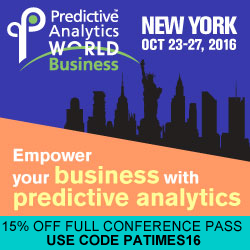Today’s business executives are increasingly applying pressure to their Human Resources departments to “use predictive analytics.” But this pressure isn’t unique to Human Resources, as these same business leaders are also pressuring Sales, Customer Service, IT, Finance, and every other line-of-business leader to do something predictive or analytical.
When Human Resources focuses on predictive analytics projects, often the department would like to know things like if employee engagement predicts anything, if it can use predictive analytics to address its diversity challenges, or if it can predict a flight-risk score based on how much training or promotions an employee has received.
Though these projects have tentative ties to other lines of business, these projects are driven primarily by an HR need or curiosity. Here are some tips for conducting a successful HR predictive analytics project that impacts the business’ bottom line:
 Our firm is often asked if we can “explore the data in the HR systems” to see if we can find anything useful. We recommend avoiding this approach, as it’s akin to reading Wikipedia like a book, hoping to find something useful.
Our firm is often asked if we can “explore the data in the HR systems” to see if we can find anything useful. We recommend avoiding this approach, as it’s akin to reading Wikipedia like a book, hoping to find something useful.
When exploring HR data – or any data – without a specific question in mind, what you’ll find are factoids that are interesting, but not necessarily actionable. You’ll pay an external consultant a lot of money to do this or have a precious internal resource do this, with no strategic impact. Avoid using the Wikipedia approach. Start with a question, not just a data set.
Like all lines of business, HR is excited to show results of its predictive analytics projects. But often, these results of an HR predictive analytics project are meaningful only to HR. The business cares about business outcomes. On this score, HR departments can learn from the marketing department, which began its predictive analytics journey before HR. When marketing was able to show that a predictive project that could identify which offers were able to increase sales, business executives took notice. Marketing stopped being “aligned with” the business; marketing was the business.
HR needs to do the same thing.
When HR begins predictive analytics projects, it needs to ask the business units what kinds of challenges they are having that might be affected by the workforce.
There are two critical categories for strategic predictive workforce projects:
To be credible, the predictive workforce initiative needs to measure and show business results both before and after the predictive model.
HR should know even better than other departments that some people have a natural mindset to “get” and love analytics, and some people simply don’t have that mindset and won’t be passionate about analytics.
HR should realize that not everyone needs to know how to perform predictive analytics. There are many traditional HR functions that still need to be accomplished. We recommend a best-practice approach of identifying people who have the mindset and interest in the analytics space and letting them partner with someone who is a true predictive analyst. And for those who aren’t cut out for predictive analytics, there are still many roles in the predictive process in which they can be incredibly effective. Here are some important roles in an HR predictive workforce analytics project that do not require getting elbow deep in data:
Greta Roberts is the CEO and Co-founder of Talent Analytics, Corp. She is the Program Chair of Predictive Analytics World for Workforce and a Faculty member of the International Institute for Analytics. Follow her on twitter @gretaroberts.